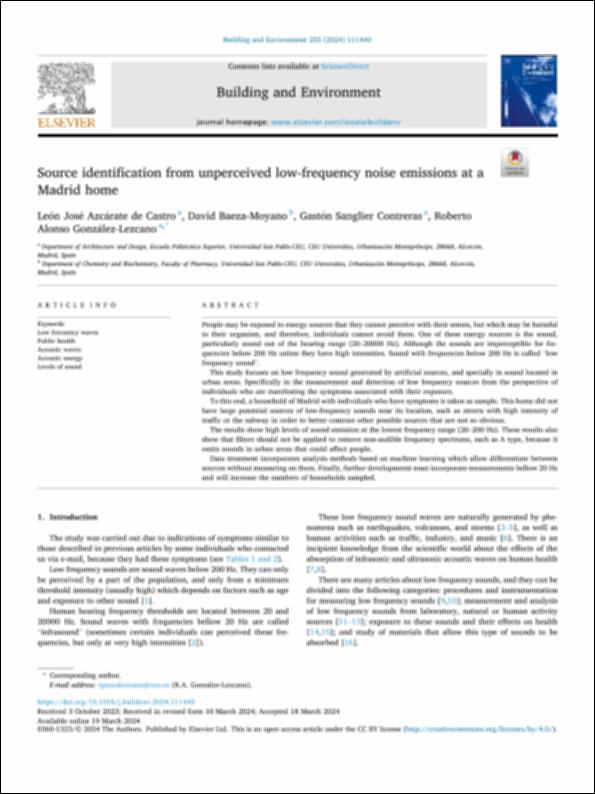Por favor, use este identificador para citar o enlazar este ítem:
http://hdl.handle.net/10637/15702Source identification from unperceived low-frequency noise emissions at a Madrid home
| Título : | Source identification from unperceived low-frequency noise emissions at a Madrid home |
| Autor : | Azcárate de Castro, León José Baeza Moyano, David Sanglier Contreras, Gastón González Lezcano, Roberto Alonso. |
| Materias: | Low frecuency waves; Public health; Acoustic waves; Acoustic energy; Levels of sound |
| Editorial : | Elsevier |
| Citación : | León José Azcárate de Castro, David Baeza-Moyano, Gastón Sanglier Contreras, Roberto Alonso González-Lezcano, Source identification from unperceived low-frequency noise emissions at a Madrid home, Building and Environment, Volume 255, 2024, 111440, ISSN 0360-1323, https://doi.org/10.1016/j.buildenv.2024.111440 |
| Resumen : | People may be exposed to energy sources that they cannot perceive with their senses, but which may be harmful to their organism, and therefore, individuals cannot avoid them. One of these energy sources is the sound, particularly sound out of the hearing range (20–20000 Hz). Although the sounds are imperceptible for frequencies below 200 Hz unless they have high intensities. Sound with frequencies below 200 Hz is called “low frequency sound”. This study focuses on low frequency sound generated by artificial sources, and specially in sound located in urban areas. Specifically in the measurement and detection of low frequency sources from the perspective of individuals who are manifesting the symptoms associated with their exposure. To this end, a household of Madrid with individuals who have symptoms is taken as sample. This home did not have large potential sources of low-frequency sounds near its location, such as streets with high intensity of traffic or the subway in order to better contrast other possible sources that are not so obvious. The results show high levels of sound emission at the lowest frequency range (20–200 Hz). These results also show that filters should not be applied to remove non-audible frequency spectrums, such as A type, because it omits sounds in urban areas that could affect people. Data treatment incorporates analysis methods based on machine learning which allow differentiate between sources without measuring on them. Finally, further developments must incorporate measurements bellow 20 Hz and will increase the numbers of households sampled. |
| URI : | http://hdl.handle.net/10637/15702 |
| Derechos: | http://creativecommons.org/licenses/by-nc-nd/4.0/deed.es Open Access |
| ISSN : | 0360-1323 |
| Cubierto por: | Acuerdo Transformativo - 2024 |
| Fecha de publicación : | 19-mar-2024 |
| Centro : | Universidad San Pablo-CEU |
| Aparece en las colecciones: | Escuela de Politécnica Superior |
Los ítems de DSpace están protegidos por copyright, con todos los derechos reservados, a menos que se indique lo contrario.


